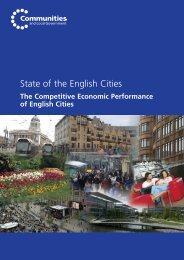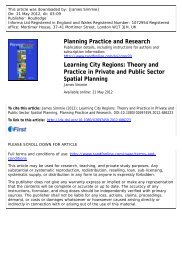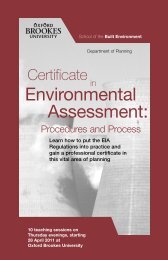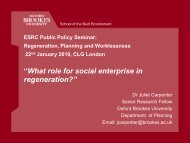History Matters: Path dependence and innovation in British city ...
History Matters: Path dependence and innovation in British city ...
History Matters: Path dependence and innovation in British city ...
You also want an ePaper? Increase the reach of your titles
YUMPU automatically turns print PDFs into web optimized ePapers that Google loves.
Executive summary<br />
<strong>History</strong> matters: A <strong>city</strong>-region’s past<br />
determ<strong>in</strong>es what is possible while the<br />
present controls what possibilities are<br />
explored<br />
Local economies’ capa<strong>city</strong> to absorb new<br />
knowledge, grow <strong>and</strong> regenerate is developed<br />
over time. Industrial growth, decl<strong>in</strong>e <strong>and</strong><br />
renewal results from historic comb<strong>in</strong>ations of<br />
knowledge assets <strong>and</strong> <strong><strong>in</strong>novation</strong>. In turn, the<br />
sectoral <strong>and</strong> structural pathways followed by<br />
cities <strong>and</strong> regions determ<strong>in</strong>e their long-term<br />
success or failure.<br />
The ‘lagg<strong>in</strong>g’ cities <strong>in</strong> our study – where<br />
economic development trails the national<br />
average (Middlesbrough, Newport, Norwich,<br />
Swansea <strong>and</strong> Wakefield) – are all characterised<br />
by weaknesses derived from their specific<br />
<strong>in</strong>dustrial histories. Conversely, ‘lead<strong>in</strong>g’ cities<br />
such as Aldershot, Cambridge, Northampton,<br />
Oxford, Read<strong>in</strong>g <strong>and</strong> Warr<strong>in</strong>gton are all<br />
characterised by their lack of <strong>in</strong>dustrial<br />
heritage.<br />
City-regional economies are <strong>in</strong>teractive<br />
systems composed of four ma<strong>in</strong> str<strong>and</strong>s<br />
1. Sectoral development pathways. The<br />
economic, social <strong>and</strong> <strong>in</strong>stitutional histories<br />
of <strong>city</strong> economies that have brought them<br />
to where they are <strong>in</strong> the present. Sometimes<br />
these can be traced back for decades if not<br />
centuries.<br />
2. Knowledge assets. These assets – which<br />
<strong>in</strong>clude universities <strong>and</strong> expenditure on<br />
research <strong>and</strong> development – have become<br />
<strong>in</strong>creas<strong>in</strong>gly significant as the role of<br />
knowledge <strong>in</strong> contemporary economic<br />
performance has <strong>in</strong>creased.<br />
3. Local <strong><strong>in</strong>novation</strong> systems. The dynamic use<br />
of knowledge to create new products <strong>and</strong><br />
services. Here the local <strong><strong>in</strong>novation</strong> system<br />
plays a critical role <strong>in</strong> comb<strong>in</strong><strong>in</strong>g local <strong>and</strong><br />
external knowledge to <strong>in</strong>ject vary<strong>in</strong>g degrees<br />
of novelty <strong>in</strong>to local economic activities.<br />
4. New path creation. More radical<br />
<strong><strong>in</strong>novation</strong>s aris<strong>in</strong>g from the local<br />
<strong><strong>in</strong>novation</strong> system sometimes generate new<br />
development pathways – when cities branch<br />
<strong>in</strong>to new <strong>in</strong>dustrial or economic sectors.<br />
New ideas <strong>and</strong> new development pathways<br />
appear more often <strong>in</strong> cities without long<br />
<strong>in</strong>dustrial histories<br />
We <strong>in</strong>vestigated five different possibilities for<br />
the creation of new development pathways.<br />
1. Indigenous (local). These <strong>in</strong>cluded the<br />
actions of ‘<strong>in</strong>dividual stars’ such as those<br />
who formed Cambridge Consultants <strong>in</strong><br />
1960 <strong>and</strong> the contemporary Vice Chancellor<br />
of Swansea University who <strong>in</strong>spired the<br />
Technium Programme launched <strong>in</strong> 2001.<br />
We expected to f<strong>in</strong>d that new firm creation<br />
played a vital role <strong>in</strong> the creation of new<br />
pathways. But new firm formation decl<strong>in</strong>ed<br />
nationally through the 1990s <strong>and</strong> was often<br />
lowest <strong>in</strong> some of the more <strong>in</strong>novative<br />
cities. We also found that the direct role of<br />
local universities as <strong>in</strong>stitutions (as opposed<br />
to a few star <strong>in</strong>dividuals emanat<strong>in</strong>g from<br />
them) <strong>in</strong> new path creation appeared to be<br />
4













